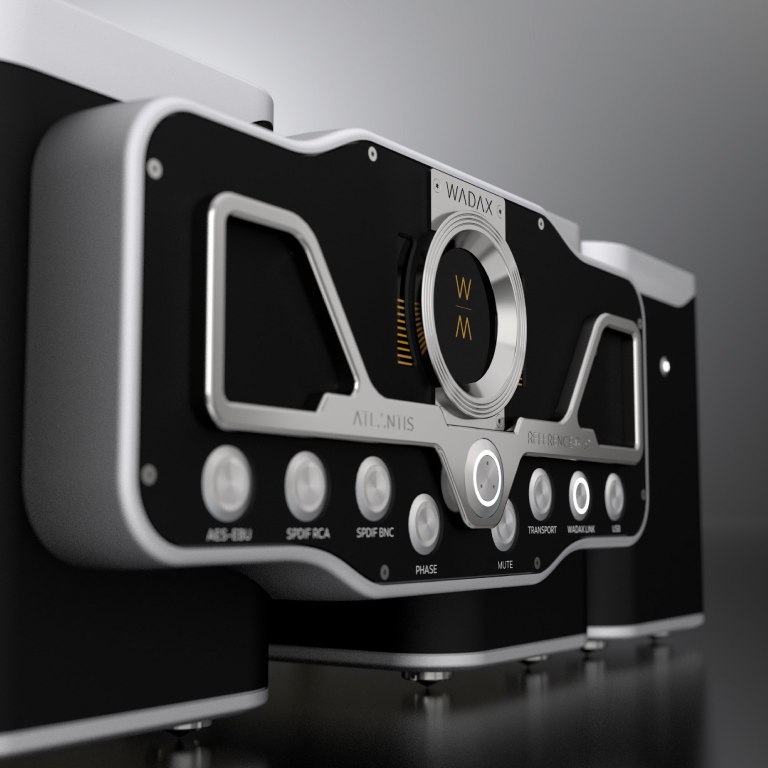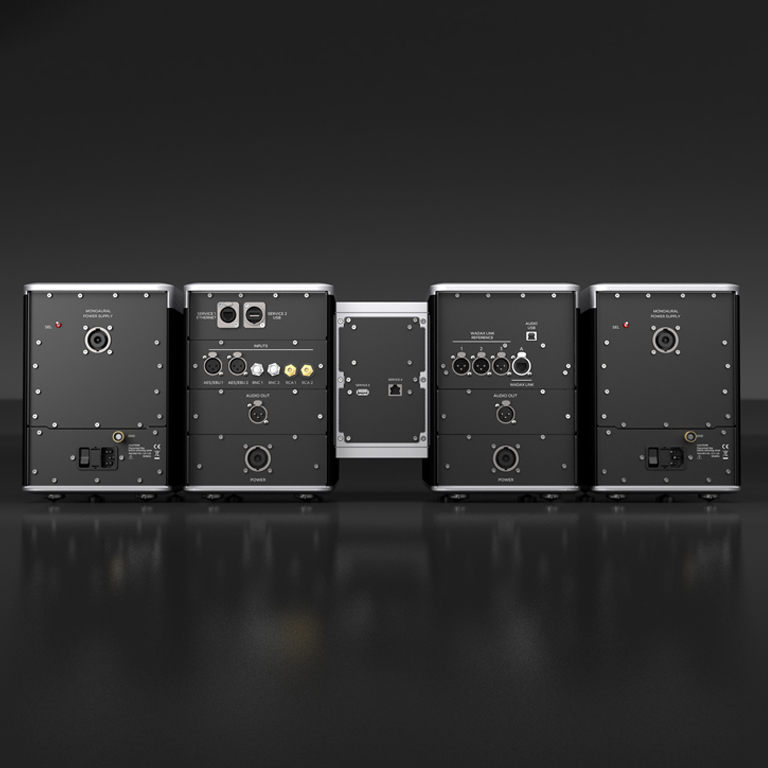
WADAX has been improving D/A technology and performance for the last 10 years: lowering the noise floor, increasing temporal and detail resolution, reducing the ‘footprint’ left by digital artefacts in the recording. The result has brought digital playback closer to live performance than ever before.
Fed back into our Fundamental Research Program, these performance improvements have revealed that, once the noise and error levels across the circuit blocks are reduced below a certain point – and in reaching that point, the original Atlantis DAC already surpasses all of the competition – the human auditory system becomes capable of far higher resolution, allowing us to perceive clocking errors, PSU interference and the effects of mechanical vibration that were always present but previously masked.
Atlantis REFERENCE DAC is our response to these findings, with lower levels of clock noise and significant improvements in PSU and mechanical isolation.
The result is a masterpiece.
The result is the most accurate and most musically satisfying DAC ever designed.


Everything about the Atlantis REFERENCE DAC is unique to this product: the clock circuitry; PSU topology and distributed regulation; the implementation of the musIC feed-forward error correction technology; the totally independent, dual-Mono DAC and analog circuitry; the fully modular construction, allowing for future upgrades or updates of key circuit blocks; the physical separation and independent housing of left and right channels, left and right channel power supplies; the mechanical vibration management incorporated in the chassis construction – and that barely scratches the surface of a product that contains 23 printed circuit boards, 10 independent, purpose-wound power transformers and over 5,500 discrete parts…
Conventional digital decoding struggles to achieve its theoretical performance: components and circuits never behave ideally, generating a complex, polluting mix of non-linearities that contaminates the delicate audio signals during and AFTER conversion. The delicate micro-information and expressive nuances in the musical signal are obscured by inter-reactions between power supplies, clocking, grounding, analog circuitry and the digital to analogue converter. To further complicate things, these non-linearities and error mechanisms are load dependent, varying with signal amplitude. Together they form the core of what we have all come to recognize as “digital sound.”
Wadax technology is founded on the unique musIC process, a sophisticated feed-forward error correction system that operates in the time domain. By mapping the error mechanisms of a chosen DAC
chip under load using Adaptive Delta Hilbert Mapping, we can develop an algorithmic that examines the incoming signal and calculates the induced error (both linear and non-linear) that will result. By applying an inverse signal at the input we can real-time correct for the time and phase error that is so musically destructive in other, conventional decoding systems.
This process requires a massive number of mathematical operations and considerable datatransfer: 12,8 GBytes/s. Processing is done at 128 bit internal resolution to precisely render the output and generate the smallest feed-forward corrections. The result is measurably and audibly the most natural and musically communicative digital decoding currently possible – something that’s obvious as soon as you hear the Atlantis REFERENCE DAC.

The output of an audio component can only be as silent as its power supply. This is especially true in digital to analogue conversion, given the massive scale of the circuits involved and the complex interaction paths within the process. For REFERENCE DAC we have implemented an ultra-sophisticated, cost no-object power supply topology, a physically and electrically independent, dual-mono design, employing 10 custom-wound transformers for total isolation of each critical section in the circuit, six stages of cascaded regulation on the AC input and over 30 local regulation stages. Once again, the result of the massive effort and huge application of state-of-the-art hardware is readily measurable and clearly audible, reflected in a total noise level (1Hz-100KHz) of only 0.5 microvolts, astonishing musical subtlety and commanding dynamic authority.
There’s no point in creating a silent electronic environment if mechanical vibration and resonance is allowed to contaminate the signal path. REFERENCE DAC employs total physical isolation of left and right channels, along with further physical separation of the mechanically noisy power-supply components from the delicate signal processing circuits. Massive, mechanically grounded chassis components are designed to sink vibrational energy and interface with sophisticated, modern equipment support solutions. Reference DAC’s three chassis elements can be arranged in a linear layout, or vertically disposed, the chassis design combining harmoniously in either situation.


Delivering the most natural musical performance at the REFERENCE DAC’s outputs is only part of the story. To deliver digital music to your system, REFERENCE DAC must accept signals from all available digital sources, whether that means optical disc replay from an Atlantis transport, including native DSD replay over our proprietary triple AES-EBU connection, file replay from an Atlantis Server or network connection, or even BlueTooth connectivity to mobile devices. Reference DAC is capable of mating with all known digital sources, is MQA compatible and its modular construction ensures that it will be able to adapt to any changes in the digital replay landscape.
Nor have we neglected the critical interface to your amplifier and speakers, with the provision of balanced (XLR) adjustable output level and output impedance, ensuring that REFERENCE DAC will offer the perfect electrical match to and will not risk overloading the input of your line-stage or amplifier.
Any attempt to approach the state-of-the-art in digital decoding and realize the theoretical benefits of the technology is unavoidably expensive, time consuming and hugely costly in terms of exotic hardware. It is also hampered by the sheer speed of digital development, progress that threatens impending obsolescence.
The Wadax REFERENCE DAC redefines the possibilities of digital music reproduction, something that is obvious a soon as you listen to it, but even a massive step-change in performance like this can and will be overtaken eventually. Which is why we have built the REFERENCE DAC as a true card-cage construction, employing no fewer than 23 individual circuit boards to carry the critical circuit blocks, ensuring that individual elements and functionality can be replaced to accommodate future technologies and developments. This allows future upgrades to be carried out in-situ, within the owner’s system, with firmware updates available over the Wadax at Home cloud system

– 23 individual printed circuit boards
– More than 5500 discrete parts
– Dual-differential musIC 3 128-bit-feed-forward error correction process
– Fully balanced, dual mono design with complete physical and electrical separation of left and right channels
– 10 purpose-wound, functionally specific power transformers
– Digital circuitry time aligned to 100ps
– 0.5uV of total rail noise (1Hz-100KHz): ultra sophisticated power supply with distributed regulation topology.
– 30 local regulation stages, 5 stages of DC regulation.
– User-adjustable gain and output impedance.
– Zepto Reference clock: doubled the master clock frequency with only 12fs total jitter.
Over 30,000 man hours devoted by passionate engineers and scientists to develop the most accurate and musical DAC ever designed.
Output Level: 1V / 2V / 4V
Output impedance: 0 / 10 / 50 / 75 / 600 ohms
Inputs: USB (32-384KHz, 16-24-32 bits, DSD64, DSD128, DSD256,MQA),
2xSPDIF RCA (32KHz-192KHz, 16-24 bits)
2xSPDIF BNC (32KHz-192KHz, 16-24 bits)
2xAES-EBU (32KHz-192KHz, 16-24 bits)Native Reference Wadax Link (native PCM, DSD), 3xAES-EBU, 1 RJ45
User interface: 5 inch capacitive touch full-colour display 800×480
Power: 110/220V, switchable, max 200W
Remote support and OTA upgrade:
software upgradeable over the Internet

